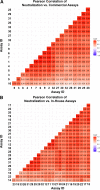Assay Harmonization Study To Measure Immune Response to SARS-CoV-2 Infection and Vaccines: a Serology Methods Study
- PMID: 37191544
- PMCID: PMC10269912
- DOI: 10.1128/spectrum.05353-22
Assay Harmonization Study To Measure Immune Response to SARS-CoV-2 Infection and Vaccines: a Serology Methods Study
Abstract
The Coronavirus disease 2019 (COVID-19) pandemic presented the scientific community with an immediate need for accurate severe acute respiratory syndrome coronavirus 2 (SARS-CoV-2) serology assays, resulting in an expansion of assay development, some without following a rigorous quality control and validation, and with a wide range of performance characteristics. Vast amounts of data have been gathered on SARS-CoV-2 antibody response; however, performance and ability to compare the results have been challenging. This study seeks to analyze the reliability, sensitivity, specificity, and reproducibility of a set of widely used commercial, in-house, and neutralization serology assays, as well as provide evidence for the feasibility of using the World Health Organization (WHO) International Standard (IS) as a harmonization tool. This study also seeks to demonstrate that binding immunoassays may serve as a practical alternative for the serological study of large sample sets in lieu of expensive, complex, and less reproducible neutralization assays. In this study, commercial assays demonstrated the highest specificity, while in-house assays excelled in antibody sensitivity. As expected, neutralization assays demonstrated high levels of variability but overall good correlations with binding immunoassays, suggesting that binding may be reasonably accurate as well as practical for the study of SARS-CoV-2 serology. All three assay types performed well after WHO IS standardization. The results of this study demonstrate there are high performing serology assays available to the scientific community to rigorously dissect antibody responses to infection and vaccination. IMPORTANCE Previous studies have shown significant variability in SARS-CoV-2 antibody serology assays, highlighting the need for evaluation and comparison of these assays using the same set of samples covering a wide range of antibody responses induced by infection or vaccination. This study demonstrated that there are high performing assays that can be used reliably to evaluate immune responses to SARS-CoV-2 in the context of infection and vaccination. This study also demonstrated the feasibility of harmonizing these assays against the International Standard and provided evidence that the binding immunoassays may have high enough correlation with the neutralization assays to serve as a practical proxy. These results represent an important step in standardizing and harmonizing the many different serological assays used to evaluate COVID-19 immune responses in the population.
Keywords: SARS-CoV-2; antibodies; harmonization; serology.
Conflict of interest statement
The authors declare no conflict of interest.
Figures



Similar articles
-
High-Throughput Neutralization and Serology Assays Reveal Correlated but Highly Variable Humoral Immune Responses in a Large Population of Individuals Infected with SARS-CoV-2 in the US between March and August 2020.mBio. 2023 Apr 25;14(2):e0352322. doi: 10.1128/mbio.03523-22. Epub 2023 Feb 14. mBio. 2023. PMID: 36786604 Free PMC article.
-
Evaluation of a Surrogate Enzyme-Linked Immunosorbent Assay-Based Severe Acute Respiratory Syndrome Coronavirus 2 (SARS-CoV-2) cPass Neutralization Antibody Detection Assay and Correlation With Immunoglobulin G Commercial Serology Assays.Arch Pathol Lab Med. 2021 Oct 1;145(10):1212-1220. doi: 10.5858/arpa.2021-0213-SA. Arch Pathol Lab Med. 2021. PMID: 34181714
-
Evaluating Humoral Immunity against SARS-CoV-2: Validation of a Plaque-Reduction Neutralization Test and a Multilaboratory Comparison of Conventional and Surrogate Neutralization Assays.Microbiol Spectr. 2021 Dec 22;9(3):e0088621. doi: 10.1128/Spectrum.00886-21. Epub 2021 Nov 17. Microbiol Spectr. 2021. PMID: 34787495 Free PMC article.
-
Overview of Neutralization Assays and International Standard for Detecting SARS-CoV-2 Neutralizing Antibody.Viruses. 2022 Jul 18;14(7):1560. doi: 10.3390/v14071560. Viruses. 2022. PMID: 35891540 Free PMC article. Review.
-
Immunity to SARS-CoV-2: What Do We Know and Should We Be Testing for It?J Clin Microbiol. 2022 Jun 15;60(6):e0048221. doi: 10.1128/jcm.00482-21. Epub 2022 Mar 7. J Clin Microbiol. 2022. PMID: 35249377 Free PMC article. Review.
Cited by
-
Performance Evaluation of Three Antibody Binding Assays, a Neutralizing Antibody Assay, and an Interferon-Gamma Release Assay for SARS-CoV-2 According to Vaccine Type in Vaccinated Group.Diagnostics (Basel). 2023 Dec 18;13(24):3688. doi: 10.3390/diagnostics13243688. Diagnostics (Basel). 2023. PMID: 38132272 Free PMC article.
-
The importance of using WHO International Standards to harmonise SARS-CoV-2 serological assays.Lancet Microbe. 2024 Mar;5(3):e301-e305. doi: 10.1016/S2666-5247(23)00258-6. Epub 2024 Jan 12. Lancet Microbe. 2024. PMID: 38224703 Free PMC article. Review.
-
Analytical measuring interval, linearity, and precision of serology assays for detection of SARS-CoV-2 antibodies according to CLSI guidelines.mSphere. 2024 Nov 21;9(11):e0039324. doi: 10.1128/msphere.00393-24. Epub 2024 Oct 31. mSphere. 2024. PMID: 39480103 Free PMC article.
-
Outpatient COVID-19 convalescent plasma recipient antibody thresholds correlated to reduced hospitalizations within a randomized trial.JCI Insight. 2024 Mar 14;9(8):e178460. doi: 10.1172/jci.insight.178460. JCI Insight. 2024. PMID: 38483534 Free PMC article. Clinical Trial.
-
Longitudinal Assessment of BNT162b2- and mRNA-1273-Induced Anti-SARS-CoV-2 Spike IgG Levels and Avidity Following Three Doses of Vaccination.Vaccines (Basel). 2024 May 9;12(5):516. doi: 10.3390/vaccines12050516. Vaccines (Basel). 2024. PMID: 38793767 Free PMC article.
References
-
- World Health Organization. 2020. WHO COVID-19 dashboard. https://covid19.who.int/. Accessed 22 August, 2022.
-
- Pinto LA, Shawar RM, O'Leary B, Kemp TJ, Cherry J, Thornburg N, Miller CN, Gallagher PS, Stenzel T, Schuck B, Owen SM, Kondratovich M, Satheshkumar PS, Schuh A, Lester S, Cassetti MC, Sharpless NE, Gitterman S, Lowy DR. 2022. A trans-governmental collaboration to independently evaluate SARS-CoV-2 serology assays. Microbiol Spectr 10:e0156421. doi:10.1128/spectrum.01564-21. - DOI - PMC - PubMed
-
- FDA. 2020. Policy for coronavirus disease-2019 tests during the public health emergency (revised). https://www.fda.gov/regulatory-information/search-fda-guidance-documents....
Publication types
MeSH terms
Substances
Grants and funding
LinkOut - more resources
Full Text Sources
Other Literature Sources
Medical
Research Materials
Miscellaneous

